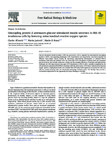Uncoupling protein-2 attenuates glucose-stimulated insulin secretion in INS-1E insulinoma cells by lowering mitochondrial reactive oxygen species
| dc.contributor.author | Affourtit, C | |
| dc.contributor.author | Jastroch, M | |
| dc.contributor.author | Brand, MD | |
| dc.date.accessioned | 2015-07-09T08:14:24Z | |
| dc.date.available | 2015-07-09T08:14:24Z | |
| dc.date.issued | 2011-03 | |
| dc.identifier.issn | 0891-5849 | |
| dc.identifier.issn | 1873-4596 | |
| dc.identifier.uri | http://hdl.handle.net/10026.1/3419 | |
| dc.description.abstract |
Glucose-stimulated insulin secretion (GSIS) by pancreatic β cells is regulated by mitochondrial uncoupling protein-2 (UCP2), but opposing phenotypes, GSIS improvement and impairment, have been reported for different Ucp2-ablated mouse models. By measuring mitochondrial bioenergetics in attached INS-1E insulinoma cells with and without UCP2, we show that UCP2 contributes to proton leak and attenuates glucose-induced rises in both respiratory activity and the coupling efficiency of oxidative phosphorylation. Strikingly, the GSIS improvement seen upon UCP2 knockdown in INS-1E cells is annulled completely by the cell-permeative antioxidant MnTMPyP. Consistent with this observation, UCP2 lowers mitochondrial reactive oxygen species at high glucose levels. We conclude that UCP2 plays both regulatory and protective roles in β cells by acutely lowering GSIS and chronically preventing oxidative stress. Our findings thus provide a mechanistic explanation for the apparently discrepant findings in the field. | |
| dc.format.extent | 609-616 | |
| dc.format.medium | Print-Electronic | |
| dc.language | en | |
| dc.language.iso | eng | |
| dc.publisher | Elsevier BV | |
| dc.subject | Pancreatic beta cells | |
| dc.subject | Glucose-stimulated insulin secretion | |
| dc.subject | Uncoupling protein 2 | |
| dc.subject | Mitochondrial respiration | |
| dc.subject | Reactive oxygen species | |
| dc.subject | Coupling efficiency of oxidative phosphorylation | |
| dc.subject | Type 2 diabetes | |
| dc.subject | Metabolic syndrome | |
| dc.subject | Free radicals | |
| dc.title | Uncoupling protein-2 attenuates glucose-stimulated insulin secretion in INS-1E insulinoma cells by lowering mitochondrial reactive oxygen species | |
| dc.type | journal-article | |
| dc.type | Article | |
| plymouth.author-url | https://www.ncbi.nlm.nih.gov/pubmed/21172424 | |
| plymouth.issue | 5 | |
| plymouth.volume | 50 | |
| plymouth.publication-status | Published | |
| plymouth.journal | Free Radical Biology and Medicine | |
| dc.identifier.doi | 10.1016/j.freeradbiomed.2010.12.020 | |
| plymouth.organisational-group | /Plymouth | |
| plymouth.organisational-group | /Plymouth/Faculty of Health | |
| plymouth.organisational-group | /Plymouth/Faculty of Health/School of Biomedical Sciences | |
| plymouth.organisational-group | /Plymouth/REF 2021 Researchers by UoA | |
| plymouth.organisational-group | /Plymouth/REF 2021 Researchers by UoA/UoA01 Clinical Medicine | |
| plymouth.organisational-group | /Plymouth/Research Groups | |
| plymouth.organisational-group | /Plymouth/Research Groups/Institute of Translational and Stratified Medicine (ITSMED) | |
| plymouth.organisational-group | /Plymouth/Research Groups/Institute of Translational and Stratified Medicine (ITSMED)/CBR | |
| plymouth.organisational-group | /Plymouth/Users by role | |
| plymouth.organisational-group | /Plymouth/Users by role/Academics | |
| dc.publisher.place | United States | |
| dcterms.dateAccepted | 2010-12-11 | |
| dc.identifier.eissn | 1873-4596 | |
| dc.rights.embargoperiod | No embargo | |
| rioxxterms.versionofrecord | 10.1016/j.freeradbiomed.2010.12.020 | |
| rioxxterms.licenseref.uri | http://www.rioxx.net/licenses/all-rights-reserved | |
| rioxxterms.licenseref.startdate | 2011-03-01 | |
| rioxxterms.type | Journal Article/Review |


